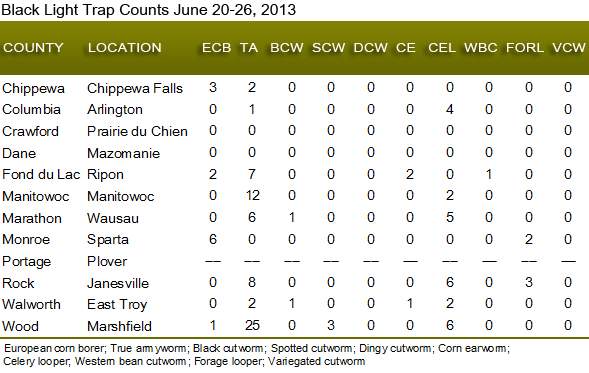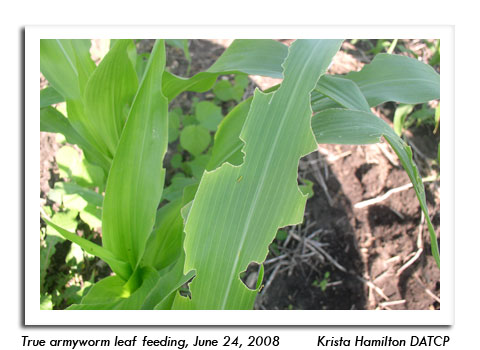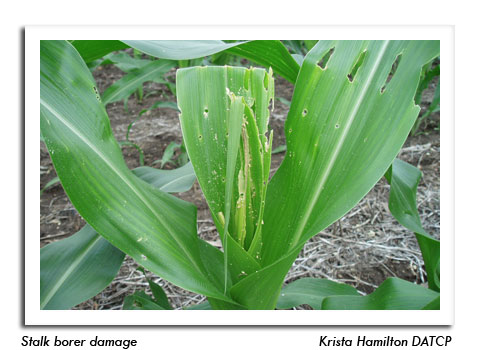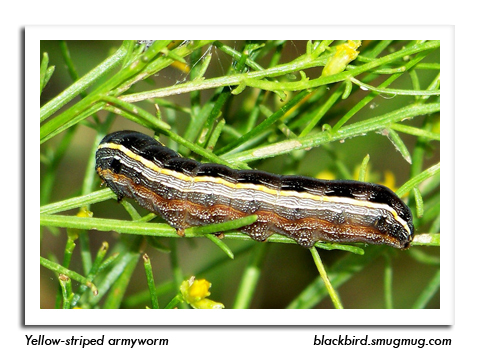
 |
|
|
Corn
Volume 58 Number 9 Date 06/27/2013 TRUE ARMYWORM - Environmental conditions remain favorable for armyworm infestations. Grassy corn and peas are common across the state and many acres of wheat are lodged from recent storms. Consultants and growers should continue to monitor these crops through mid-July for developing problems. Minor infestations in corn were detected in Dane, Green, Richland and Vernon counties in the last week, as well as in Clark, Eau Claire, Jackson, Portage and Wood counties the week before. STALK BORER - Damage is apparent on a small percentage of plants in individual fields, principally along the margins. Less than 3% of the plants were affected in corn checked in Richland, Rock and Sauk counties, although in Green County, some fields were noted to have 8% of the plants in the edge rows infested with third- and fourth-instar larvae. CORN EARWORM - Surveys of V3-V7 field corn found light corn earworm infestations in Dodge, Green and Iowa counties, with larvae ranging in size from ½- to ¾-inch long. Leaf feeding by the early-instar caterpillars was noted on 1-4% of the plants in four of 45 fields sampled. The larvae observed are the result of an early migration of moths that began on May 29. Significant populations of corn earworm larvae seldom occur this early in Wisconsin and specific thresholds have not been established for vegetative-stage field corn, but treatment decisions can be made based on the percentage of fresh whorl feeding and the presence of live larvae. A comparable recommendation for the true armyworm calls for treatment when 50% of the whorls show injury and contain larvae. YELLOW-STRIPED ARMYWORM - Localized populations have been noted in Dane and Green counties and larvae are appearing in alfalfa fields. Damage attributed to this caterpillar has not surpassed economic levels, but the combination of armyworms, corn earworms and variegated cutworms could push infestation levels above-threshold. Larvae of all three species are present in scattered cornfields at this time. SLUGS - Reports indicate slug defoliation is common in cornfields, and recent surveys found minor leaf feeding on approximately 25-70% of plants in a at a few sites in Columbia, Dodge, Fond du Lac, Richland and Sauk counties. The problem is unlikely to subside until drier weather returns and control may be warranted if 40% or more of plants show defoliation, wet conditions persist, and the slugs are actively feeding. EUROPEAN CORN BORER - The spring flight has peaked in the southern two-thirds of the state. Oviposition on corn, vegetable and weed hosts should have intensified with the warmer temperatures and high humidity in the last week, although the heavy rains on the nights of June 21-26 may have interfered with moth oviposition activity. According to the European corn borer degree-day model, the first flight is expected to peak around 631 degree days (modified base 50°F). -- Krista Hamilton, DATCP Entomologist 





|
|
|